An excerpt of this post appears in Irish public historian Martine Brennan’s powerful project “Enslavement to Citizenship” documenting Irish-born Americans’ participation in slavery.
William McWhir: Irish-Born Educator, Clergyman, Slaveholder
William McWhir – born in County Down, Ireland in 1759 and ordained as a Presbyterian clergyman there – was a well-known educator and clergyman of his time in the United States. He knew George Washington well, and corresponded with him. After McWhir’s death in Georgia in 1859, he was acknowledged as one of the two most famous educators in Georgia. He was a founding member of the Georgia Historical Society, married the widow of an American Revolutionary War hero, and was an active member of the clergy during the whole of his long life.
He also owned human beings.
McWhir owned at least 20 enslaved people, valued at $8,000, during his lifetime. In 1839, he sold them, and lived off the profits from that sale for the rest of his life. The memoirs of McWhir’s life make no mention of this fact, yet it would have been one of the central economic pillars of his life.
How did a man born into a farming family “in comfortable circumstances” in Ireland become owner of a plantation and enslaved Africans on the swampy, hurricane-prone coast of Georgia?
According to memoirs by his wife’s family, McWhir was born in the parish of Moneyrea, County Down, Ireland, on September 9, 1759, to James and Jean (Gibson) McWhir. He was a homely child, and a bout with smallpox that cost him an eye and his complexion did nothing to improve his looks. His father and grandfather had both been elders in the Presbyterian church and so, despite lack of any calling, he was pushed into study of religion in Belfast and at the University of Glasgow. He was ordained by the Presbytery of Killiheagh in 1783.
He had long been interested in America, and decided immediately after his ordination, right at the end of the American Revolution, to move there in hopes of bettering his situation. He quickly obtained a teaching position in Alexandria, Virginia, at an academy attended by George Washington’s nephews. In fact, Washington’s nephews actually boarded with McWhir for some time, but McWhir eventually begged off keeping them, hinting that they were unmanageable.
McWhir exchanged letters with Washington, but he may have overstated his connection with Washington in his stories to friends in later life; Washington declined to give McWhir a reference when he decided to move to Georgia, stating, “It is with reluctance, Sir, that I decline a compliance with your wishes to give you letters to certain Gentlemen in Georgia. But I am persuaded, that when you recollect that I have had no opportunities of obtaining a personal knowl[e]dge of your talents & qualifications as a teacher, you will readily see the impropriety there would be in my undertaking to recommend upon these points where I am not qualified to judge, and will therefore impute my declining to comply with your request to its just cause.”
McWhir is said to have kept Washington’s letters to him for the rest of his life, but they unfortunately appear to have been burned by his family with their other papers when Sherman’s Army entered Savannah during the American Civil War.
In 1793 he accepted a call from the people of Sunbury, on the Georgia coast south of Savannah, to head the Sunbury Academy and their Presbyterian Church.
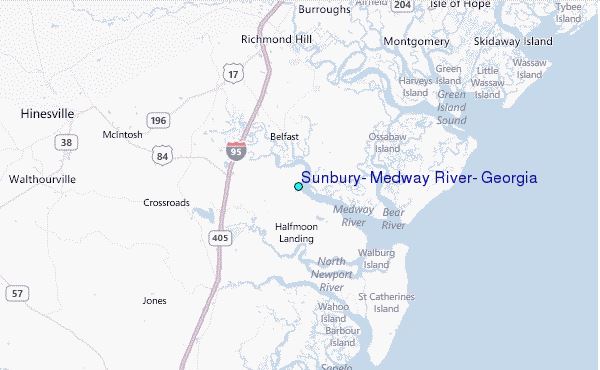
There he met Mary Jones LaPina Baker, the recent widow of Colonel John Baker, a Revolutionary War hero who had been a member of the Council of Safety of 1776 and commanded a regiment of militia in what became Liberty County after the Revolution succeeded. He became her third husband.
Several references say that McWhir prospered from his teaching income and was able to buy Springfield Plantation before their marriage, but other records indicate that Springfield had been owned by Col. Baker, whose 1789 will left Mary “five Negroes viz. Flora Hannah Cumba Prince and Bob” and two tracts of land, one formerly owned by [Isaac] Antrobus.
After the 1789 will but prior to his 1792 death, Colonel John Baker and wife Mary had sold Baker’s son John Baker the latter’s “inheritance” and also the enslaved people left in the will to Mary. In 1793, after his father’s death, John Baker sold Mary Baker (his stepmother), a 300-acre tract of land originally granted to Edward Baker in 1774 and a 100-acre tract for a total of 100 pounds sterling, presumably the tracts left to her by Colonel Baker. He also sold her, for 500 pounds sterling, “all those eight negroe slaves named Flora, Hannah, Nanny, Quash, Prince, Cumba, Boson, and Amaritta,” plus cattle, hogs and furniture –of which had been left her in the will but sold to Baker before his father’s death.
No bill of sale was found documenting McWhir’s purchase of Springfield plantation, so it appears likely that he obtained it, and presumably the enslaved people, through his marriage, as married women could not own property unless it was put into trust for them upon the marriage, and there is no evidence this happened with Mary. From the following surviving records, it is not clear whether Baker left his wife Springfield Plantation, or whether she and McWhir sold the land he left her and later purchased Springfield.
Note how much more these enslaved human beings were valued than was the land. This unequal balance would hold true through the end of the Civil War, because the land was almost valueless without people who could be forced to work on it.
In 1795, McWhir and wife Mary sold 150 acres of the land to Elizabeth Farrar of Liberty County for 87 pounds sterling. The land was described as originally belonging to Isaac Antrobus and bordering land owned by the late Roger Kelsall, known as the Distillery, land of Thomas Maxwell on the Midway River, and land then owned by John Hardee. Mary McWhir attached a statement swearing she was entering into the sale of her own free will.
In 1803, McWhir, in his own name, without Mary, sold “one negro man named Jack” to merchants in Savannah for $350.

Also in 1803, William and Mary McWhir sold to Mrs. Elizabeth Munro of Liberty County “all that piece parcel or tract of land situate & being in Liberty County & State aforesaid about one & half miles from Sunbury containing two hundred and eighty one acres and in the year one thousand seven hundred & eighty eight was bounded southwardly by Jerimeah [alt: Jeremiah] Dickson Land westwardly by Nathaniel [name] & Nathaniel Bacon’s land northwardly by lands of John Baker Eastwardly by lands belonging to the estate of Stephen Dickinson reference to a deed of John Dollar dated fifteenth of June one thousand seven hundred and eighty eight will more fully appear…” Mary McWhir again attached a statement swearing she was entering into the sale of her own free will.
During this time, McWhir continued as an educator and a clergyman, albeit somewhat intermittently due to poor health. In 1815, he was received into the Harmony Presbytery of Georgia. In 1819, when wife Mary died, their marriage having produced no children, he decided to visit his only brother in Ireland. What must his brother have thought of his tales of conversation with George Washington, the rigors of life in coastal Georgia, where the extremely destructive 1804 hurricane had cost him much money, and his ownership of enslaved people?
After his return to Georgia, now in his 60s, he traveled from church to church acting as a “supply” preacher in Bryan, Liberty and McIntosh counties. A local clergyman, Reverend Charles Colcock Jones, himself also both a clergyman and a slaveholder, described him as a man “of mercurial temperament, of a high sense of honor and justice, and of strict integrity, energetic and prompt in decision and action…his schools were always models of morality and of order. He was a terror to evil doers.” He further said that McWhir always dressed and comported himself as a clergyman and wanted to always be seen as such. Numerous sources recall him as a very strict disciplinarian who did not spare the rod.
Although his former students and his wife’s family described him affectionately in their memoirs, not all felt that way. Mrs. Eugenia Jones Bacon’s 1898 memoir of her life in antebellum Liberty County lightly disguised him as “Father McCall,” and described him thus: “…after a long and arduous life in pulpit and country school, the aged clergyman had, as his sole earthly possessions, an old white horse, Bob, and a faithful coloured man, Daniel. His declining year he spent visiting among his former pupils. Our parent was his favorite one—to judge from the frequency of his visits. And the mere memory of interminable hours of agony that ensued for Letha and me, still revive apprehension. In fact, whenever we recognized the jogging trot of old Bob coming down the avenue, we fled,–if we could.” She described his scoldings when one of them happened to doze off during his interminable prayers around the family altar and stories of his “cruelty when in charge of a country school.”
Mrs. Bacon had disguised McWhir’s name but she did not disguise the name of his “faithful coloured man, Daniel.” In 1846, McWhir “traded” a young enslaved man named Bounty, 17 or 18 years old, to Charlton Hines, a planter of Liberty County, in return for “a certain negro slave named Daniel about twenty two years old, the property of the said estate of Lewis Hines (Charlton’s brother) as servant and waiting man to him the said William McWhir during his natural life and that after the death of the said William McWhir, the said Daniel shall be returned to the said Charlton Hines executor as aforesaid or his successor or legal representative of said estate.” Bounty was included in inventories of Lewis Hines’ estate from 1847-1855. On 1 January 1855, when the estate was inventoried and divided again, Bounty was assessed at a value of $1000 and given to Caroline C. Hines as part of his (yes, his) share of the estate.
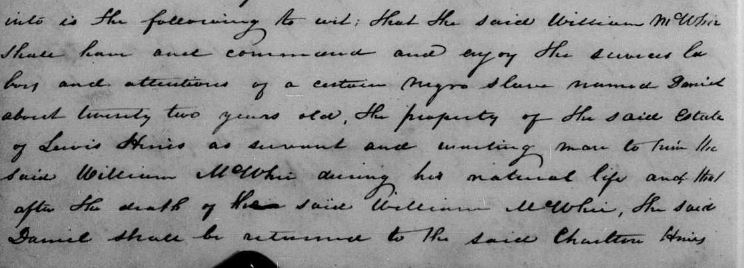
In 1839, there was a financial panic in the United States in which the price of cotton dropped dramatically and many coastal Georgia planters experienced financial distress and even ruin. In 1839, McWhir sold twenty enslaved people — Joe, Susannah, Joannah, Monday, Betsey, Phoebe, Isabel, Young Joe, Hetty, Biner [Binah], Jim, Nanny, Bounty, Simon, Beck, Sam, Peter, Zauger, Cato, and Alsendore – to Francis M. Stone, a prominent alderman and tax collector of Savannah.
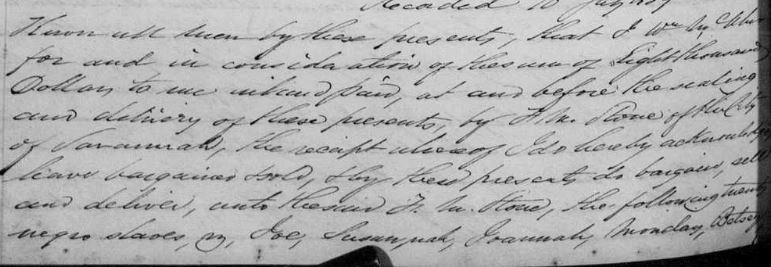
The enslaved people netted $8000 for McWhir, which he used to support himself, and he in fact loaned the money back to Stone in 1844. Stone used the same enslaved people he had purchased from McWhir as collateral for the loan: “the following named and described Negro slaves being twenty one in number to wit Joe aged about fifty five years Susannah aged about fifty five years Monday aged about thirty years Joe aged about twenty one years Joanna aged about thirty five years Betsey aged about twenty five years Phoebe aged about twenty two years Isabel aged about nineteen years Hetty child of Joanna aged about thirteen years Mary child of baged about three years Dennis also child of Betsey aged about one year Binah aged about forty three years Cato aged about fifty five years Jim aged about thirty years Nanny aged about eighteen years Bounty aged about sixteen years Beck aged about twelve years, Simon aged about eight years, Cato [or Kato] aged about four years and an infant child of Binah aged about eight months and Sam aged about fifty five years together with the future issue and increase of the female slaves….” Stone paid off the note by 1849, as attested by McWhir’s step-grandson, Edward J. Harden, with whom he lived in Savannah for some time.
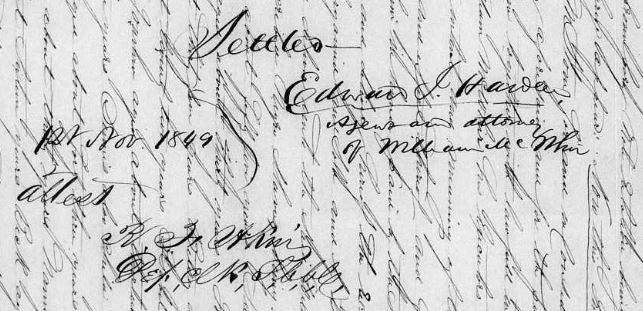
What happened to Springfield Plantation? No record has yet been found of McWhir selling it to Francis M. Stone along with the 20 enslaved people, but that seems likely, as Stone sold Springfield in 1839 to Thomas J. Dunham of Liberty County for $1475. It was named as such and described as “formerly the property of the Rev’d William McWhir, containing five hundred acres more or less, bound on one side by lands of Thomas J. Dunham, on the opposite side by lands of the late Major John Stevens on the other side by marsh land. ”
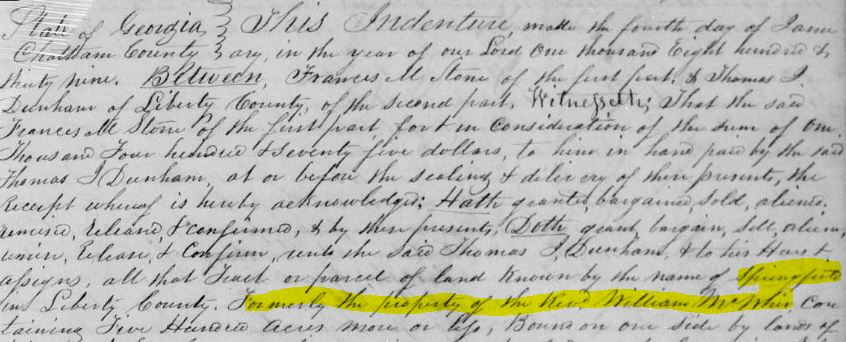
The next year, Dunham sold it for $1200 to John Stevens. These men were all neighbors and related by marriage to each other and to McWhir through his marriage to Mary Jones LaPina Baker.
What must it have been like for these enslaved people to have been owned by a man known as a strict disciplinarian who did not hesitate to flog his young students? A man known as a strict disciplinarian in a time when corporal punishment was considered acceptable? A man of whom the Reverend Charles Colcock Jones said delicately after McWhir’s death, “The name of no man who ever lived in Georgia was more intimately identified with the cause of education…as a teacher, his chief merits were thoroughness of instruction and the most exact discipline, such as would, in these days, be esteemed too rigorous.”
One fortunate factor, perhaps, was that McWhir probably did not spent much time supervising the people he was holding enslaved, since he traveled from church to church. They were likely managed by an overseer or family member.
Released from the ties of ownership of land and human beings by the 1839 sale, McWhir spent the rest of his life on visits to family and former pupils. He died in 1851 at the South Hampton plantation home of Roswell King, Jr., who himself was notorious for his mistreatment and rapes – proven by DNA — of the enslaved people he supervised while acting as foreman for Pierce Mease Butler at his Butler Island plantation near Darien in McIntosh County.
According to William Harden, McWhir’s step-great grandson: “Dr. McWhir died at the residence of Roswell King, Esq. in Liberty County on Friday, the 31st of January 1851, in the ninety-second year of his age. For many years before his death he was affectionately called by those who knew him ‘Father McWhir.’” Mrs. Bacon told a different story in her memoir (with McWhir’s identity lightly disguised): “Father McCall, however died at the age of eighty-three at a neighbour’s, in a room named Purgatory. Owing to his dislike for the old clergyman, whom he nevertheless had to entertain, the host had assigned him to this chamber.”
His funeral service was conducted by Rev. I.S.K. Axson, also a slaveholder, at the Midway Church on February 2, 1851, then he was buried in the Sunbury Cemetery next to his wife.
McWhir mentioned no enslaved people in his 1847 will, having apparently sold them all previously, with Daniel evidently returning to the ownership of Charlton Hines, as a Daniel, valued at $2000, was listed in Charlton Hines’ 1864 estate inventory. McWhir stated in his will that he owed little in the way of debts, and bequeathed his remaining funds, derived from slavery profits, as follows:
-American Bible Society – $500
-American Tract Society in New York – $1000
-American Colonization Society – $500
-American Society for melioration of the condition of the Jews – $300
-to his friend William W. McIntosh and his wife – $500
-to his friends Col. John J. Maxwell & his wife – $500
-to the Reverend William McIntosh – $300
-to the Reverend Dr. Charles C. Jones and his wife – $300
-to the Midway Congregational Church of Liberty County – $300
-to his (step) grandson Thomas H. Harden and his wife – $300
-to his (step) granddaughter Mrs. Matilda H. Galphin – $300
-to his (step) grandson Edward J. Harden – $2000
These individuals were all well off at the time. It seems possible that McWhir may have left them money in proportion to the amount of time he lived with them, as he evidently still had considerable money left from the amount he had earned by selling the people he held enslaved.

McWhir’s cane, said to have been brought with him from Belfast, Ireland, can be seen in the Midway Museum in Liberty County. According to a Museum docent, it is made of blackthorn and has three copper rings on the shaft that say, “faith, hope and charity.”
An odd addendum to McWhir’s story: in 1850, McWhir was recorded in the U.S. federal census as living with step-grandson Edward J. Harden in Savannah. Listed in the household was a black woman named Dolly McWhir, 65 years old. An enslaved woman would not be listed in the household in the 1850 census, so Dolly appears to have been free. Her name was not in any of the documents showing McWhir’s ownership of people. She was not listed in the 1860 census, but would have been 75, so may have passed away. Who was she to McWhir?
And what happened to the 20 enslaved people McWhir sold to Francis M. Stone? Stone had used them as collateral on a loan in 1844, and the loan was paid off in 1849. However, they were not listed in Stone’s estate inventory after his death in 1864, and no deed has yet been found documenting his sale of them. Research continues to try to find out their fate.
Sources:
Memoirs of William McWhir by family members:
“William McWhir, An Irish Friend of Washington,” by William Harden, p. 197, Georgia Historical Quarterly, volume 1, 1917.
Wilson, John S. (John Simpson), 1796-1873, and Presbyterian Church in the U.S. Synods. Georgia. The Dead of the Synod of Georgia: Necrology; Or, Memorials of Deceased Ministers, Who Have Died During the First Twenty Years After Its Organization. Atlanta: Franklin Print. House, 1869. [Available to read online] [This work contains the text of a letter from Reverend Charles Colcock Jones that is cited above.]
McWhir’s reputation as one of the two most famous Georgia schoolmasters and the details of his funeral service: “The Two Most Famous of Georgia Schoolmasters,” published in The Atlanta Constitution newspaper, April 26, 1891 (accessed in Newspapers.com).
Exchange of Correspondence with Georgia Washington: See https://founders.archives.gov/search/Correspondent%3A%22McWhir%2C%20William%22%20Correspondent%3A%22Washington%2C%20George%22.
For the letter declining to keep Washington’s nephews any longer: “To George Washington from William McWhir, 8 March 1788,” Founders Online, National Archives, https://founders.archives.gov/documents/Washington/04-06-02-0128. [Original source: The Papers of George Washington, Confederation Series, vol. 6, 1 January 1788 – 23 September 1788, ed. W. W. Abbot. Charlottesville: University Press of Virginia, 1997, p. 148.]
For the letter in which Washington declined to give him letters of reference: “From George Washington to William McWhir, 17 February 1793,” Founders Online, National Archives, https://founders.archives.gov/documents/Washington/05-12-02-0114. [Original source: The Papers of George Washington, Presidential Series, vol. 12, 16 January 1793 – 31 May 1793, ed. Christine Sternberg Patrick and John C. Pinheiro. Charlottesville: University of Virginia Press, 2005, pp. 161–162.]
Ownership of Springfield Plantation by Colonel John Baker: “Early Days on the Tidewater,” by Buddy Sullivan.
McWhir’s 1847 Will: “Georgia Probate Records, 1742-1990,” database with images, FamilySearch, Chatham County > Wills 1827-1852 vol G-H > Wills Book H 1839-1852, pp. 415-417 (images 472-3). Link: https://www.familysearch.org/ark:/61903/3:1:3QS7-893G-D5BP?i=471&wc=9SYB-ZN5%3A267655101%2C268103401&cc=1999178)
Mrs. Eugenia Jones Bacon’s recollection of McWhir: “Lyddy: a tale of the old South” by Mrs. Eugenia Jones Bacon, published 1898 by Continental Publishing Co of New York; digital version found at Archive.org: https://archive.org/details/lyddytaleofoldso00bacoiala/page/48/mode/2up
Court Records:
1792 sale of land and enslaved people by Colonel John and Mary Baker to John Baker (Jr): Liberty County Superior Court, “Deeds & Mortgages v.Deeds & Mortgages v. B 1787-1793,” p. 458-460, Colonel John Baker and Mary Baker to John Baker Jr; digital image, FamilySearch.org, “Deeds & Mortgages, v. A-B 1777-1793” within “Deeds and mortgages, 1777-1920; general index to deeds and mortgages, 1777-1958,” image #510-1, (https://www.familysearch.org/ark:/61903/3:1:3Q9M-CSLZ-FLTR?i=509&cat=292358), accessed 3/15/2021)
1793 sale of land and enslaved people by John Baker (Jr) to Mary Baker (Colonel John Baker’s widow): Liberty County Superior Court, “Deeds & Mortgages v. DD 1795-1798,” p. 100-2, John Baker to Mary Baker; digital image, FamilySearch.org, “Deeds & Mortgages, v. C-D 1793-1801” within “Deeds and mortgages, 1777-1920; general index to deeds and mortgages, 1777-1958,” image #68-9, (https://www.familysearch.org/ark:/61903/3:1:3Q9M-C3QP-5PDG?cat=292358), accessed 3/11/2021)
1795 sale of land by William and Mary McWhir to Eliza Farrar: Liberty County Superior Court, “Deeds & Mortgages v. DD 1795-1798,” p. 174-6, William and Mary McWhir to Elizabeth Farrar; digital image, FamilySearch.org, “Deeds & Mortgages, v. C-D 1793-1801” within “Deeds and mortgages, 1777-1920; general index to deeds and mortgages, 1777-1958,” image #320-2, (https://www.familysearch.org/ark:/61903/3:1:3Q9M-C3QP-5172?i=319&cat=292358, accessed 3/7/2021)
1803 sale by William and Mary McWhir of land to Mrs. Elizabeth Munro: Liberty County Superior Court, “Deeds & Mortgages v. E 1801-1804,” p. 232, William and Mary McWhir to E. Monroe; digital image, FamilySearch.org, “Deeds & Mortgages, v. E-G 1801-1816” within “Deeds and mortgages, 1777-1920; general index to deeds and mortgages, 1777-1958,” image #126, https://www.familysearch.org/ark:/61903/3:1:3Q9M-C3QL-J969-9?i=125&cat=292358, accessed 3/7/2021)
1803 sale of Jack by McWhir to Williamson and Morell, merchants in Savannah: Chatham County Superior Court, “Deeds & Mortgages v. 1X 1838-1839,” p. 232, William McWhir to Williams and Morell; digital image, FamilySearch.org, “Deeds & Mortgages, v. 1X-1Y 1802-1805” within “Deeds and mortgages, 1777-1920; general index to deeds and mortgages, 1777-1958,” image #128, (https://www.familysearch.org/ark:/61903/3:1:3Q9M-C3QP-Y99C-G?i=127&cat=140778, accessed 3/8/2021)
1839 sale of 20 enslaved people by McWhir to Francis M. Stone of Savannah: Chatham County Superior Court, “Deeds & Mortgages v. 2W 1838-1839,” p. 482, William McWhir to F.M. Stone; digital image, FamilySearch.org, “Deeds & Mortgages, v. 2V-2W 1837-1839” within “Deeds and mortgages, 1777-1920; general index to deeds and mortgages, 1777-1958,” image #551, (https://www.familysearch.org/ark:/61903/3:1:3Q9M-C3Q5-W4BD?i=550&cat=140778, accessed 3/7/2021)
1839 sale of Springfield plantation by Francis M. Stone to Thomas J. Dunham: Liberty County Superior Court, “Deeds & Mortgages v. L 1838-1842,” p. 98, Francis M. Stone to Thomas J. Dunham; digital image, FamilySearch.org, “Deeds & Mortgages, v. K-L 1831-1842” within “Deeds and mortgages, 1777-1920; general index to deeds and mortgages, 1777-1958,” image #376, (https://www.familysearch.org/ark:/61903/3:1:3Q9M-C3QP-T9KW-C?i=375&cat=292358, accessed 3/11/2021)
1840 sale of Springfield plantation by Thomas J. Dunham to John Stevens: Liberty County Superior Court, “Deeds & Mortgages v. L 1838-1842,” p. 215-6, Thomas J. Dunham to John Stevens; digital image, FamilySearch.org, “Deeds & Mortgages, v. K-L 1831-1842” within “Deeds and mortgages, 1777-1920; general index to deeds and mortgages, 1777-1958,” image #436, (https://www.familysearch.org/ark:/61903/3:1:3Q9M-C3QP-T9VP-9?i=435&cat=292358, accessed 3/12/2021)
1844 use by Stone of the enslaved people on a promissory note to McWhir: Chatham County Superior Court, “Deeds & Mortgages v. 3B 1843-1844,” p. 344-5, William McWhir to F.M. Stone; digital image, FamilySearch.org, “Deeds & Mortgages, v. 3A-3B 1842-1844” within “Deeds and mortgages, 1777-1920; general index to deeds and mortgages, 1777-1958,” image #535-6, (https://www.familysearch.org/ark:/61903/3:1:3Q9M-C3Q5-7WBY?i=534&cat=140778, accessed 3/7/2021)
1846 exchange by William McWhir and Charlton Hines of the enslaved men Bounty and Daniel: Family Search.org. Liberty County Superior Court “Deeds and mortgages, 1777-1920; general index to deeds and mortgages, 1777-1958,” Film: Deeds & Mortgages, v. M-N 1842-1854,” Record Book M, pp. 438-9. Image #277 (Link: https://www.familysearch.org/ark:/61903/3:1:3Q9M-C3QP-5H22?i=276&cat=292358) Transcript: https://theyhadnames.net/2019/11/29/exchange-mcwhir-hines/.
1864 Charlton Hines estate inventory naming Daniel: “Georgia Probate Records, 1742-1990,” database with images, FamilySearch (https://familysearch.org/ark:/61903/3:1:3QS7-L93L-RJ96?cc=1999178&wc=9SYY-ZNP%3A267679901%2C268025701 : 20 May 2014), Liberty > Wills 1863-1942 vol C-D > image 43 of 430